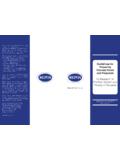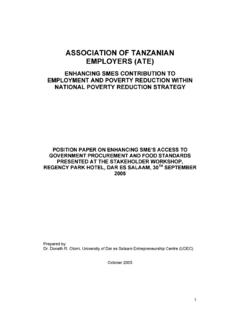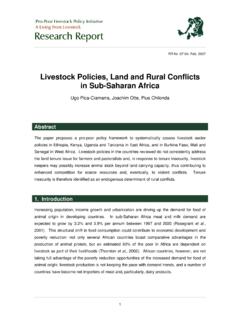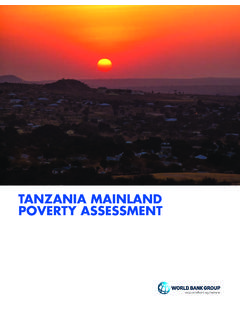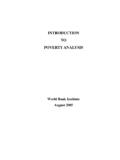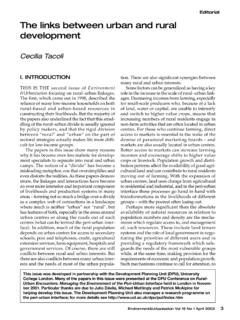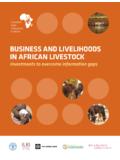Transcription of ReVIew The challenge of South African schooling ...
1 50 2011 Transformation Audit: From Inequality to Inclusive GrowthReVIew | The challenge of South African schooling : dimensions, targets and initiativesLinda ChisholmThe crisis in South African schooling is not new. It predates the achievement of democracy in 1994 and has been an ongoing refrain in public discourse since 1994. What is new is the emerging consensus on its dimensions and causes. Since the 1990s, both the government and donors have invested substantial resources in understanding what exactly the problems may be.
2 The government has not been slow to respond to such findings, but in the welter of everyday crisis-talk, these responses have gone largely unnoticed and are rarely analysed and discussed. The resulting public debate is the poorer for it. It is important to analyse these directions, however, and to understand them, as they form part of a wider palimpsest of debates and approaches not only in South Africa but also globally. The crisis discourse surrounding education and the policy approaches adopted locally resonate with international debates.
3 The discourse is one of comparative learning per-formance and what to do about it. This article accordingly considers what some of the research informing government thinking shows on the dimensions and causes of the education quality challenge , what the government is doing about it, how it fits into broader international debates and what it means. The challenges in schoolingDimensionsThe quality of education, linked to equity in the system, was identified as the main challenge facing South African education since the early 1990s. Its principal manifestation until recently was matric results.
4 However, as international and provincial assessments of children s literacy and numeracy skills lower down in the system gathered momentum, so the full extent of the problem in South Africa was also laid bare through scholarly and popular syntheses and elaborations of the evidence relating to underperformance (Reddy 2006; Howie 2007; Howie & Plomp 2008; Fleisch 2008; Bloch 2009; Taylor & Yu 2009). Despite improvements in more equitable spending, relieving poor schools of fee burdens, introducing school nutrition, increasing the number of children attending Grade R classes, achieving near-universal enrolment in the compulsory phase of schooling and dramatically expanding the number of qualified teachers in the system, learning outcomes are still abysmal by any measure (DBE 2011a).
5 Recent assessments provide ample evidence. The United Nations Educational, Scientific and Cultural Organisation (UNESCO) and Southern African Development Community (SADC) collaboration in the form of the Southern and Eastern African Consortium for Monitoring Education Quality (SACMEQ) has enabled comparison of Grade 6 literacy and numeracy capabilities across the SADC region at two key points in 2000 and 2007 (see IIEP, UNESCO & SACMEQ 2011). South Africa does well on gender equality and a gradual reduction of its high repetition rates over the period, but there is no change in the overall trend for South African pupils reading achievement and a negligible improvement in their mathematics achievement.
6 South Africa performed below the SACMEQ mean in both reading and numeracy. South Africa also performed worse than other much poorer countries in the region, such as Swaziland and Tanzania (IIEP 2010). One of the most telling findings is the association between household poverty and learning achievement. As UNESCO pointed out in its analysis, children from the wealthiest house-holds in South Africa are ten times as likely as children from the poorest households to score well on reading. This is more than double the comparable wealth differential for Namibia , which has a similar level of achievement to that of South Africa (UNESCO 2011: 87).
7 Most disturbing of all, however, have been the results of the education department s own annual national assessments (ANAs), first conducted in 2009 and again in 2011 (DBE 2011a). The tests were administered in all Grade 1 6 classes across the country, and the Human Sciences Research Council verified the results and conducted an analysis of learners responses. The ANAs not only document and confirm the wide disparity in test scores between schools located in different socio-economic contexts, and progressive deterioration in results from Grades 1 to 6, but also provide insight into what children are getting wrong and, consequently, are not learning to do (DBE 2011b).
8 The latter is instructive. On the whole, children simply did not understand what they were being asked, even when they were responding in their home language. Handwriting, even beyond the Foundation Chapter 3: Skills and Education 51 THREEP hase, revealed a lack of writing practice. Children were unable to answer simple grammar questions, including spelling of commonly used words, the proper use of prepositions, plural forms, tenses and opposites. Reading comprehension was limited, as was the children s ability to write their own text from given prompts.
9 A Joint Education Trust school-effectiveness study (see Taylor 2011) has provided similar in-depth information on reading. The study estimates that, on average, South African children perform writing of any kind in language classes once in about four days, despite the curriculum providing time for language teaching every day. In the ANA numeracy tests, children were unable to perform basic numeracy operations, such as subtraction, multiplication and division, involving whole numbers. They had seriously limited or distorted conceptions of fractions and could not translate a problem given in words and write it in a way that enables them to solve the problem.
10 Common mathematical misconceptions seem to be shared by teachers and students (Carnoy, Chisholm & Chilisa forthcoming; Taylor 2011). Not surprisingly, in part as a consequence of such little learning, there are high repetition rates in the lower grades and high drop-out rates in the higher grades. So, although South Africa can be proud of its high enrolment and attendance rate, as well as the achievement of gender parity in enrolment and performance, its repetition rates are much higher than the international norm, especially among boys in the lower grades, and far fewer girls excel academically than should be the case (Motala & Dieltiens 2010).
